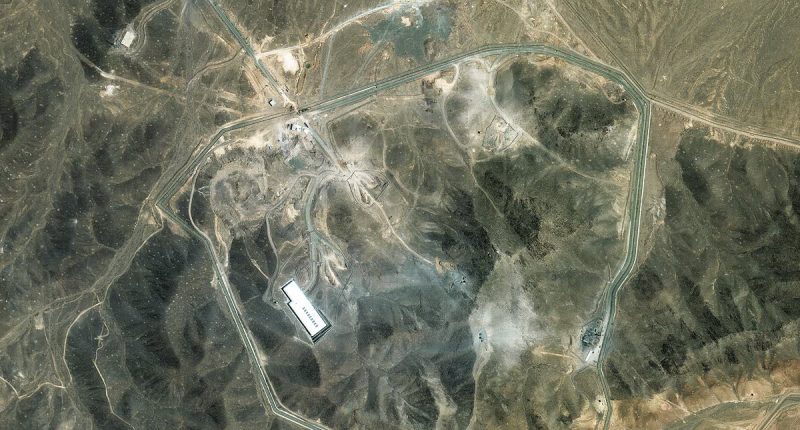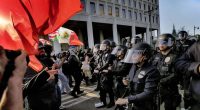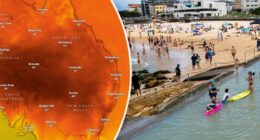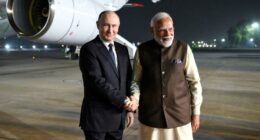Share this @internewscast.com
New satellite photos have revealed that Iran is trying to piece together its nuclear site after the US sensationally bombed it last week.
Heavy machinery was observed at the Fordow site, suggesting that Iran has ramped up its construction and excavation activities at the nuclear facility following US B-2 bombers striking it last Saturday during Operation Midnight Hammer.
Activity was seen near the tunnel entrances and near the points where the American buster bombs struck in Trump’s early-morning attack.
Additionally, construction equipment was seen creating new access roads and repairing the damage to the main road to reinstate access to the nation’s primary nuclear site.
US President Donald Trump announced that the strikes had ‘completely obliterated’ Iran’s nuclear program, setting it back by years. However, new aerial images reveal that the Middle Eastern nation had taken preliminary steps to safeguard its facility.
Iranian media said the sites had been evacuated prior to the strikes and the enriched uranium was transported to a ‘safe location.’
It is unclear how much uranium was left at the site during the bomb, but officials said there is no contamination after the strikes.
Earthwork also showed signs tunnel entrances might have been sealed off before the attacks, Newsweek reported.

Heavy machinery was seen at the Fordow site as it appeared Iran has intensified its construction and excavation of the nuclear site after US B-2 bombers struck it last Saturday in Operation Midnight Hammer

Activity was seen near the tunnel entrances and near the points where the buster bombs struck

Vehicles can be seen near a damage site at the Fordow nuclear facility
Similar construction activity was seen at the Fordow site prior to the strikes, where Iranians were seen shipping contents from the nuclear site to another location a half a mile away.
Despite the extent of the damage being up to question, International Atomic Energy Agency – the UN’s nuclear watchdog – said Fordow’s centrifuges were ‘no longer operational’ and suffered ‘enormous damage.’
A leaked preliminary report from the Defense Intelligence Agency, a US government intelligence group, suggested there was ‘low confidence’ that that Middle Eastern country’s program had been set back.
Even Iran’s Ayatollah Ali Khamenei has said the United States hit Tehran’s nuclear sites but achieved ‘nothing significant.’
‘Anyone who heard [Trump’s] remarks could tell there was a different reality behind his words – they could do nothing,’ the 86-year-old Iranian leader said.
The Trump Administration – including Defense Secretary Pete Hegseth and Director of National Intelligence Tulsi Gabbard – pushed back on the report.
Hegseth slammed the media for diminishing the strikes, which Trump compared to Hiroshima.
‘Your people are trying to leak and spin that it wasn’t successful, it’s irresponsible,’ he said at a press conference.
Pictured: The Fordow facility before and after the US strikes

The newly released images show the exactitude of military attacks, which Trump claimed flattened the Isfahan facility

US President Donald Trump said the strikes ‘completely obliterated’ Iran’s nuclear program and set it back years, but the new satellite images suggest the Middle Eastern country had taken preliminary effort to protect its facility
‘There’s nothing that I’ve seen that suggests that what we didn’t hit exactly what we wanted to hit in those locations,’ he explained without offering further evidence that the uranium was destroyed.
Trump has threatened to sue The New York Times and CNN for reporting on the preliminary report.
The Times reported Thursday that Trump’s personal lawyer Alejandro Brito had reached out to the newspaper and said the article had damaged the president’s reputation.
The letter demanded The Times ‘retract and apologize for’ the story, calling it ‘false,’ ‘defamatory’ and ‘unpatriotic.’
The newspaper’s lawyer responded by noting that Trump administration officials had confirmed the existence of the report after The Times published its findings.
‘No retraction is needed,’ The Times’ lawyer David McCraw said in a letter. ‘No apology will be forthcoming. We told the truth to the best of our ability. We will continue to do so.’
A spokesperson for CNN told The Times that the cable news network had responded to Trump’s lawyer in a similar fashion.
Operation Midnight Hammer marked the end of a 45-year stand-off between the United States and Iran.

A leaked preliminary report from the Defense Intelligence Agency, a US government intelligence group, suggested there was ‘low confidence’ that that Middle Eastern country’s program had been set back. President Trump has pushed back on the report
![Even Iran's Ayatollah Ali Khamenei has said the United States hit Tehran's nuclear sites but achieved 'nothing significant.' He said: 'Anyone who heard [Trump's] remarks could tell there was a different reality behind his words - they could do nothing'](https://i.dailymail.co.uk/1s/2025/06/28/14/99814381-14856319-Even_Iran_s_Ayatollah_Ali_Khamenei_has_said_the_United_States_hi-m-142_1751116532180.jpg)
Even Iran’s Ayatollah Ali Khamenei has said the United States hit Tehran’s nuclear sites but achieved ‘nothing significant.’ He said: ‘Anyone who heard [Trump’s] remarks could tell there was a different reality behind his words – they could do nothing’
Trump warned Iran not to try and rebuild its nuclear program.
‘I don’t think they’ll ever do it again,’ he said while attending a NATO summit. ‘They just went through hell. I think they’ve had it. The last thing they want to do is enrich.’
But the president also didn’t rule out another airstrike if necessary.
When asked whether the US would strike again if Iran built its nuclear enrichment program, he replied: ‘Sure.’
In total, the US launched 75 precision-guided munitions, including more than two dozen Tomahawk missiles, and more than 125 military aircraft in the operation against three nuclear sites.






